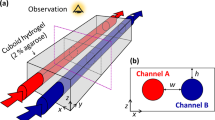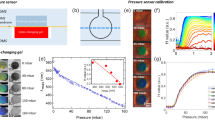Abstract
Hydrogels have been developed to respond to a wide variety of stimuli1,2,3,4,5,6, but their use in macroscopic systems has been hindered by slow response times (diffusion being the rate-limiting factor governing the swelling process). However, there are many natural examples of chemically driven actuation that rely on short diffusion paths to produce a rapid response7. It is therefore expected that scaling down hydrogel objects to the micrometre scale should greatly improve response times. At these scales, stimuli-responsive hydrogels could enhance the capabilities of microfluidic systems by allowing self-regulated flow control. Here we report the fabrication of active hydrogel components inside microchannels via direct photopatterning of a liquid phase. Our approach greatly simplifies system construction and assembly as the functional components are fabricated in situ, and the stimuli-responsive hydrogel components perform both sensing and actuation functions. We demonstrate significantly improved response times (less than 10 seconds) in hydrogel valves capable of autonomous control of local flow.
This is a preview of subscription content, access via your institution
Access options
Subscribe to this journal
Receive 51 print issues and online access
$199.00 per year
only $3.90 per issue
Buy this article
- Purchase on Springer Link
- Instant access to full article PDF
Prices may be subject to local taxes which are calculated during checkout




Similar content being viewed by others
References
Tanaka,T. et al. Phase transitions in ionic gels. Phys. Rev. Lett. 45, 1636–1639 ( 1980).
Hu,Z., Zhang,X. & Li,Y. Synthesis and application of modulated polymer gels. Science 269, 525–527 (1995).
Tanaka,T., Nishio,I., Sun,S.-T. & Ueno-Nishio,S. Collapse of gels in an electric field. Science 218, 467–469 (1982).
Suzuki,A. & Tanaka,T. Phase transition in polymer gels induced by visible light. Nature 346, 345– 347 (1990).
Kataoka,K., Miyazaki,H., Bunya,M., Okano,T. & Sakurai,Y. Totally synthetic polymer gels responding to external glucose concentration: their preparation and application to on-off regulation of insulin release. J. Am. Chem. Soc. 120, 12694–12695 (1998).
Miyata,T., Asami,N. & Uragami,T. A reversibly antigen-responsive hydrogel. Nature 399, 766–769 ( 1999).
Schmidt-Nielsen,K. Animal Physiology (Cambridge Univ. Press, Cambridge, 1975).
Kovacs,G. T. A. Micromachined Transducers Sourcebook (WCB McGraw-Hill, Boston, 1998).
Trimmer,W. S. N. Microrobots and micromechanical systems. Sensors Actuators 19, 267–287 (1988).
Smela,E., Inganäs,O. & Lundström,I. Controlled folding of micrometer-size structures. Science 268, 1735–1738 (1995).
Breen,T., Tien,J., Oliver,S. R. J., Hadzic,T. & Witesides, G. M. Design and self-assembly of open, regular, 3D mesostructures. Science 284, 948–951 (1999).
Jackman,R. J., Brittain,S. T., Adams,A., Prentiss,M. G. & Whitesides, G. M. Design and fabrication of topologically complex, three-dimensional microstructures. Science 280, 2089–2091 (1998).
Kenis,P. J., Ismagilov,R. F. & Whitesides, G. M. Microfabrication inside capillaries using multiphase laminar flow patterning. Science 285, 83 –85 (1999).
Cumpston,B. H. et al. Two-photon polymerization initiators for three-dimensional optical data storage and microfabrication. Nature 398 , 51–54 (1999).
Jo,B.-H., Lerberghe,L. M. V., Motsegood, K. M. & Beebe,D. J. Three-dimensional micro-channel fabrication in polydimethylsiloxane (PDMS) elastomer. J. Micromech. Syst. 9, 76– 81 (1999).
Acknowledgements
This work was supported by DARPA-MTO.
Author information
Authors and Affiliations
Corresponding author
Rights and permissions
About this article
Cite this article
Beebe, D., Moore, J., Bauer, J. et al. Functional hydrogel structures for autonomous flow control inside microfluidic channels. Nature 404, 588–590 (2000). https://doi.org/10.1038/35007047
Received:
Accepted:
Issue Date:
DOI: https://doi.org/10.1038/35007047
This article is cited by
-
Modular microfluidics for life sciences
Journal of Nanobiotechnology (2023)
-
Finite deformation analysis of the rotating cylindrical hollow disk composed of functionally-graded incompressible hyper-elastic material
Applied Mathematics and Mechanics (2023)
-
Carboxymethyl cellulose foams: fabrication, aqueous stability, and water capture
Journal of Materials Science (2023)
-
Bio-actuated microvalve in microfluidics using sensing and actuating function of Mimosa pudica
Scientific Reports (2022)
-
Hydrogels as functional components in artificial cell systems
Nature Reviews Chemistry (2022)
Comments
By submitting a comment you agree to abide by our Terms and Community Guidelines. If you find something abusive or that does not comply with our terms or guidelines please flag it as inappropriate.



